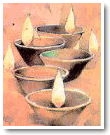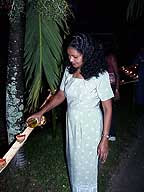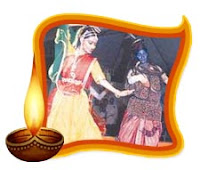16 November 2007
Hi All,
Our haul-out at the Power Boats Yard is complete, and we (that would be Tom & Schatze) are back afloat again.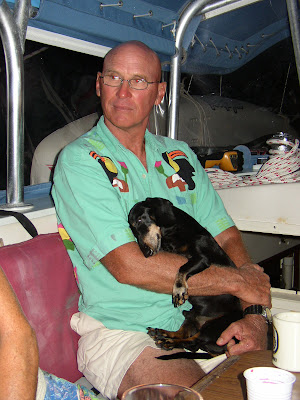 Schatze the Dog seems to be OK, and appears to have returned to his perky little self after his near-death experience falling off the boat while on the hard last week. He has even regained his Charlie Chapman like jaunty little gait, so his right forefoot must be on the mend. We are really lucky to still have him with us! Our 0830 launch at Power Boats Yard on Monday became a noon launch after the yard's 30 year-old Travel Lift broke down twice with S/V Jean Marie in the slings; no surprise though - it had broken down with a boat in the slings each day the previous three days! Our first delay was to put the drive chain back on the drive sprocket after the initial attempt to move off the working lot, and then we experienced a second delay en route to the launch slip toinspect a wheel-bearing that did not particularly like going around corners; "just being careful Skip..." At any rate, we eventually made the trip back to the water safely, and overall we did have a very positive experience at the Power Boats Yard.
Schatze the Dog seems to be OK, and appears to have returned to his perky little self after his near-death experience falling off the boat while on the hard last week. He has even regained his Charlie Chapman like jaunty little gait, so his right forefoot must be on the mend. We are really lucky to still have him with us! Our 0830 launch at Power Boats Yard on Monday became a noon launch after the yard's 30 year-old Travel Lift broke down twice with S/V Jean Marie in the slings; no surprise though - it had broken down with a boat in the slings each day the previous three days! Our first delay was to put the drive chain back on the drive sprocket after the initial attempt to move off the working lot, and then we experienced a second delay en route to the launch slip toinspect a wheel-bearing that did not particularly like going around corners; "just being careful Skip..." At any rate, we eventually made the trip back to the water safely, and overall we did have a very positive experience at the Power Boats Yard.
Hi All,
Our haul-out at the Power Boats Yard is complete, and we (that would be Tom & Schatze) are back afloat again.
 Schatze the Dog seems to be OK, and appears to have returned to his perky little self after his near-death experience falling off the boat while on the hard last week. He has even regained his Charlie Chapman like jaunty little gait, so his right forefoot must be on the mend. We are really lucky to still have him with us! Our 0830 launch at Power Boats Yard on Monday became a noon launch after the yard's 30 year-old Travel Lift broke down twice with S/V Jean Marie in the slings; no surprise though - it had broken down with a boat in the slings each day the previous three days! Our first delay was to put the drive chain back on the drive sprocket after the initial attempt to move off the working lot, and then we experienced a second delay en route to the launch slip toinspect a wheel-bearing that did not particularly like going around corners; "just being careful Skip..." At any rate, we eventually made the trip back to the water safely, and overall we did have a very positive experience at the Power Boats Yard.
Schatze the Dog seems to be OK, and appears to have returned to his perky little self after his near-death experience falling off the boat while on the hard last week. He has even regained his Charlie Chapman like jaunty little gait, so his right forefoot must be on the mend. We are really lucky to still have him with us! Our 0830 launch at Power Boats Yard on Monday became a noon launch after the yard's 30 year-old Travel Lift broke down twice with S/V Jean Marie in the slings; no surprise though - it had broken down with a boat in the slings each day the previous three days! Our first delay was to put the drive chain back on the drive sprocket after the initial attempt to move off the working lot, and then we experienced a second delay en route to the launch slip toinspect a wheel-bearing that did not particularly like going around corners; "just being careful Skip..." At any rate, we eventually made the trip back to the water safely, and overall we did have a very positive experience at the Power Boats Yard. We highly recommend Power Boats as they are head & shoulders above the other yards in Chaguaramas. (That tells you something about Trini 'maintenance programs," doesn't it? Last week Coral Cove Marina dropped their SECOND BOAT this season.) Power Boats does have a superb staff, a clean well-run boatyard,
and when the new Travel Lift gets here (they say that it's on order), their operation should go much more smoothly. (I cannot even IMAGINE trying to import a new Travel Lift, and getting it cleared through T&T Customs - at least 4 bureaucrats ought to be able to retire to Tobago off those "fees"...) Once waterborne, we returned the short distance to Hart's Cut in Carenage Bay, and are anchored off the Trinidad & Tobago Sailing Association (TTSA), our Southern Caribbean base of operations.
Tom is busy cleaning and putting the boat back together after a 3 week yard period, and working the Project List. How is it that after 3 weeks of intensive work on the hard, the Project List is even longer than when we started! What's up with that?
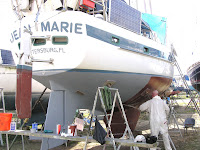 Sometime within the next few weeks Tom & Schatze will make the overnight passage to the south coast of Grenada, so that we can restart the T&T Immigration clock, intending to return in January. We will be in Grenada for a week or so around Christmas and New Years, and then sail back to Trinidad. Warm regards,
Sometime within the next few weeks Tom & Schatze will make the overnight passage to the south coast of Grenada, so that we can restart the T&T Immigration clock, intending to return in January. We will be in Grenada for a week or so around Christmas and New Years, and then sail back to Trinidad. Warm regards,
Tom & Schatze the Dog
S/V Jean Marie
Chaguaramas, Trinidad
Schatze sez: Hey, anybody out there got some food they could spare - this character is absolutely hopeless in the Galley!
and when the new Travel Lift gets here (they say that it's on order), their operation should go much more smoothly. (I cannot even IMAGINE trying to import a new Travel Lift, and getting it cleared through T&T Customs - at least 4 bureaucrats ought to be able to retire to Tobago off those "fees"...) Once waterborne, we returned the short distance to Hart's Cut in Carenage Bay, and are anchored off the Trinidad & Tobago Sailing Association (TTSA), our Southern Caribbean base of operations.
Tom is busy cleaning and putting the boat back together after a 3 week yard period, and working the Project List. How is it that after 3 weeks of intensive work on the hard, the Project List is even longer than when we started! What's up with that?
Tom & Schatze the Dog
S/V Jean Marie
Chaguaramas, Trinidad
Schatze sez: Hey, anybody out there got some food they could spare - this character is absolutely hopeless in the Galley!
